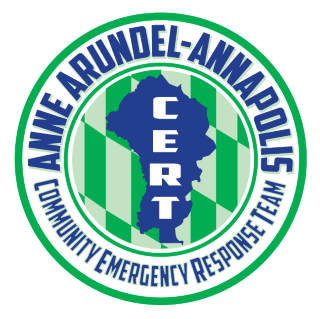On June 5, members of the Anne Arundel-Annapolis Community Emergency Response Team (AAACERT), along with other volunteers, supported a simulated mass-casualty response exercise at Thurgood Marshall BWI Airport in Linthicum, MD. The Anne Arundel Community College (AACC) paramedic program conducted the drill in concert with BWI safety personnel and the Anne Arundel County Fire Department to train paramedic students as they pursue certification in their program. Held just off the runway amid arriving and departing aircraft, the exercise centered on a decommissioned airplane that has been the site of numerous responder training scenarios. AACC adjunct instructor Joe Cvach estimated that approximately 40-50 individuals were involved in the exercise.
The scenario in play was a flight that had had violence aboard and a subsequent hard landing with injuries. The paramedic students’ initial task was to triage the “victims” as quickly as possible. Each victim had an assigned status and was stationed aboard the aircraft, so the students faced the obstacle not only of handling an overwhelming number of casualties, but also of transporting those victims who were “red” (unable to move and needing immediate care and transport) and “yellow” (injured and unable to move, but stable enough to have care delayed beyond basic first aid until critical patients are handled). Having set up appropriate triage areas, the students had to monitor patients constantly to ensure the victims’ status had not changed before they could be transported.

In the hotwash following the exercise, the evaluators noted that the transportation piece of a mass-casualty incident (MCI) is often the most complex and challenging. Students were reminded of mutual aid compacts in place among private sector and government entities to assist with matters such as staging and transportation in situations of extenuating circumstances like an MCI. Victims also offered perspectives on patient care that could help the students as they move forward in their training.
Michael Weekley, of the Upper Marlboro CERT, has participated in numerous exercises, including active shooter drills at the Metro, the Naval Academy, and the Internal Revenue Service building. “In every previous drill I’ve done, I’ve been triaged “black” – I’m hoping I get to be a survivor this time,” said Weekley. (He was “green” – walking wounded.)
Neal Anders of AAACERT discussed the training benefit to CERT members of volunteering as a victim, beyond the obvious assist it gives first responders. This was Anders’s second time playing a victim. In his last assignment, playing the role of a tornado disaster victim, he noted that successive groups of responders in the same, repeated simulation handled his case differently. “As a victim, I could see that people sometimes make mistakes; this gives me a chance to experience it from the other side and make mental notes on what I might do differently.” Anders discussed his earlier experience in a wide-area search training class, where he was taught to ask himself, “’Why did I miss things?’ You can miss obvious things because you’re so focused on a task. Those are the sorts of lessons being a victim teaches you.”

One of the paramedic students, Manfred Tambe, is also a nurse; Tambe is originally from the West African country of Cameroon. “To me, this exercise [and others like it] is the reason safety and security in [the U.S.] are the best in the world.” Tambe noted that, in the paramedic program, he has learned valuable information that complements his role as a medical provider at the hospital.
Participants came from a number of sources – some victims, like AAACERT’s Rosy Dorffner (“It lets you use your inner Sarah Bernhardt,” she said wryly), are frequent participants. Others were wives, friends, fellow AACC students, and even some off-duty responders. Anne Arundel County Fire Department personnel attended to carry out the role they normally would in such an incident.
Tambe perhaps summed up the day’s activities best: “It is so important to take time to prepare. Failing to prepare is preparing to fail.” With their efforts to plan and drill, the instructors, responders, trainees, and victims clearly intend to succeed at saving lives.
Cover photo: A decommissioned aircraft in a secure area of BWI Airport was the site of the MCI drill. (Photo by Laurie Goodell)
